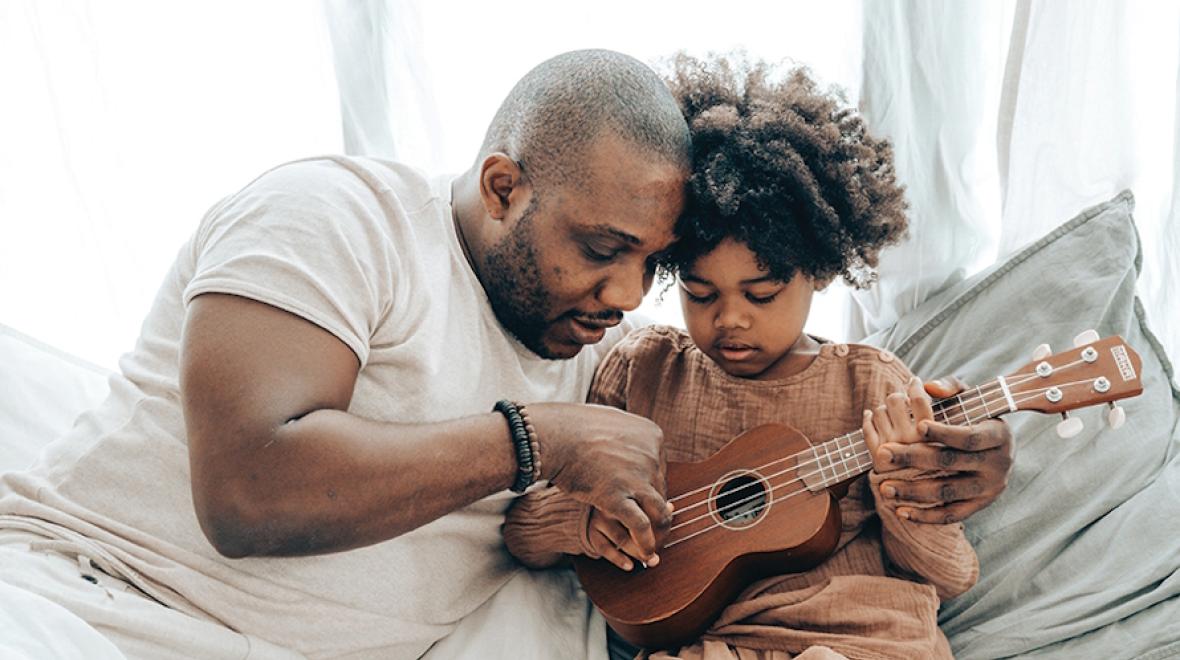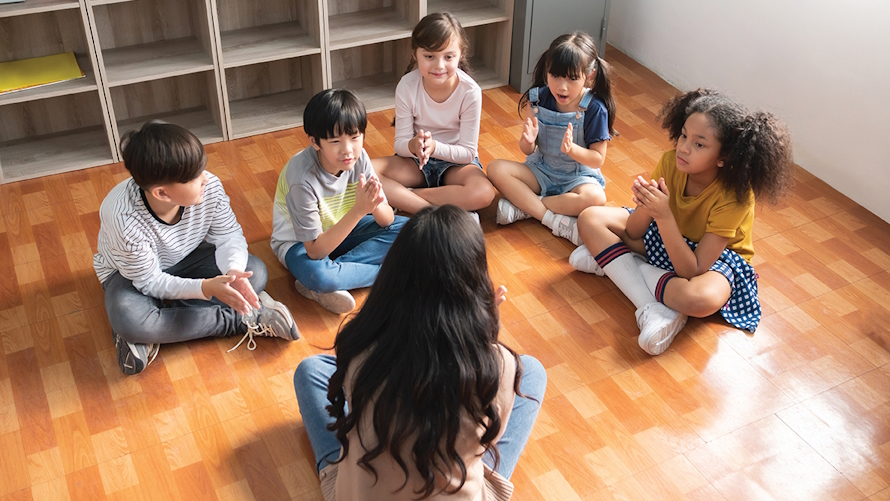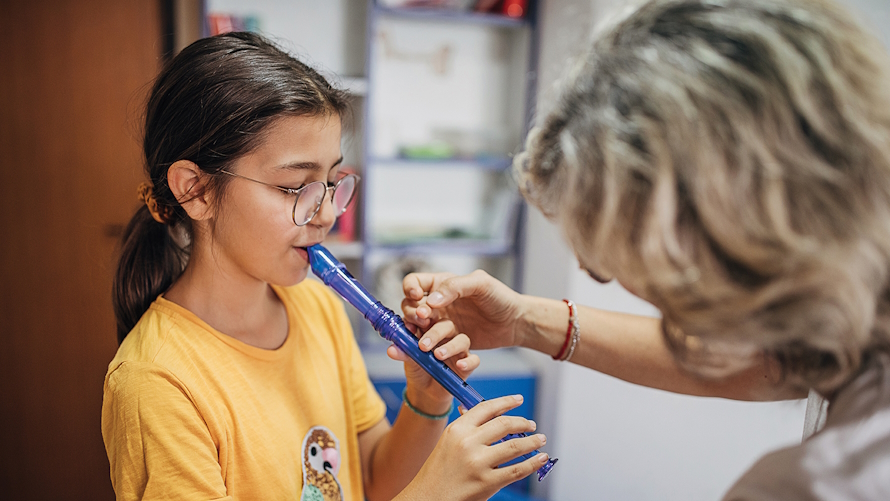
If you’ve ever listened to a breakup song on repeat, you know music can be therapeutic. It helps us to communicate, process our emotions and even form social bonds with people who share our taste. But music can be more than a dose of self-help, it can actually be a clinical form of therapy.
“Music therapy is a way to work on nonmusical goals using music,” says Kristin Schneider, a certified music therapist who was program manager of music therapy and early childhood at Music Works Northwest for six years. “The whole goal of music therapy is to do this hard work in a way that feels playful and creative and fun.”
The work of music therapy
With its approach tailored to the individual patient, music therapy is commonly applied toward developmental goals with neurodivergent youths. Music therapy goals include improving fine and gross motor skills, impulse control, self-advocacy, communication, team building and leadership skills. It is used to treat children who are experiencing developmental delays because of illnesses that have kept them in the hospital or otherwise interfered with normal experiences and stimulation. Music therapy is also helpful for children dealing with anxiety about surgeries and other frightening medical procedures.
“Depending on what the goals are, we can do instrument play, singing, musical games, musical stories, pretend play using instruments and materials in the room, dancing — it can go a lot of different directions,” says Schneider. A child may play musical games on the piano to improve fine motor skills. A patient experiencing muscle weakness or partial paralysis can practice drumming to strengthen the weak side of their body. Or a music therapist might play music as a distraction to reduce a child’s pain perception during a blood draw.
Tanesha Ross is a certified music therapist at Seattle Children’s Hospital and a neurologic music therapy fellow who specializes in the way music affects the brain.
“When you’re listening to a song and you start to tap your foot without realizing it, that’s called entrainment. If someone’s mobility is impaired, having a steady rhythmic stimulus can actually assist their motor function because we start to entrain. If I’ve got a metronome going or a song with a beat that matches the rhythm a patient needs, their motor cortex starts to kick in, entraining to that stimulus, and they start to move their body more fluidly without thinking about it so much,” says Ross.
Besides encouraging rhythmic movement in physical rehabilitation, music can affect our heart rate. Just as athletes play fast-paced music to pump themselves up for competition, a music therapist can play music while gradually slowing the tempo to calm an anxious child.
Therapy vs. instruction

Whether families approach music therapy with a specific goal in mind or simply with curiosity about how it can be helpful, the therapeutic approach is always personalized to the specific child’s needs. Patients can stop music therapy after accomplishing a single goal. But because it can be a lot more fun than other types of therapy, many families continue using music therapy to progress through a series of more challenging goals or even take on different types of goals. “There’s always something new to work on,” says Schneider. But music therapy, even when it looks like a music lesson, is not about learning to play an instrument.
“There is no wrong way for your child to explore music. A lot of times parents want to guide their children in therapy sessions, but really, it’s about the process and about them finding their own way. Really stepping back and seeing what the child comes up with, that exploration in and of itself is developmentally appropriate and helpful. We don’t want to stifle that creativity,” says Ross.
Even when a therapy session is organized like a music lesson, musical knowledge is a secondary gain. For example, therapeutic music lessons help a therapist build rapport with kids and teens through music before addressing depression and anxiety using more traditional talk therapy.
Sometimes music therapy does lead to a passion for music. At Music Works, patients who develop an interest in music can shift from therapy to adapted music lessons. Even in adapted music lessons, there are usually nonmusical goals, such as focusing attention or improving memory. When a patient’s goals become musical, they move on to become music students with a teacher instead of a therapist.
Accessing music therapy

At Seattle Children’s, music therapy is part of the creative arts therapies (CATS) group in the Child Life Department. It is offered one-on-one to all inpatients, often by referral “if the occupational, speech or physical therapist thinks that the underlying musical elements can optimize the work that they’re doing,” says Ross. But parents of Seattle Children’s patients can also request music therapy, and outside of the hospital, most music therapy is initiated through self-referral.
“If their child has any interest in music, or learns through music, then music therapy could be a great fit. For example, if you have a child who does not communicate verbally but likes to sing, or they dance whenever they hear music,” suggests Schneider.
Ross agrees, saying, “We want that motivational piece to be there.” Especially with very young children, music can be a motivator to overcome the defiance children may display in other therapeutic modalities. But if a child is not particularly interested in music, the therapy will not be as effective.
Music Works most commonly works with kids, teens and adults with autism, Down syndrome or learning disabilities through private, weekly sessions. An exception is when music therapy is specifically designed to help young people learn to function in a group. The group therapy program is not meant to teach neurotypical social skills, but uses music to provide an avenue for self-discovery. “They’re learning about ‘What do I need in order to feel comfortable in a group?’ ‘How can I self-advocate?’ ‘What are my sensory needs when I’m with so many people?’” explains Schneider.
Unfortunately, health insurance does not always cover music therapy, and rarely allows for direct billing. But a bill recently passed in Washington state may make it easier to get reimbursed for music therapy in the future. Once the law takes effect in 2025, it will be illegal to offer music therapy services without a state license. Until then, any musician or therapist can claim to offer music therapy.
Qualified music therapists will be board certified. Certification requires a bachelor’s degree with much of the same coursework as a music major as well as additional coursework in anatomy, psychology and special education. Graduates must then gain 1,200 hours of clinical experience through an internship before becoming eligible to take the certification exam. You can find board-certified music therapists on the website of the American Music Therapy Association.











